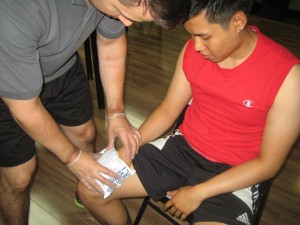A bruise is a common skin injury that occurs when trauma is exerted onto the skin which causes the skin underneath to bleed causing the discoloration. People commonly get bruises in their lives and this happens when they bump into something. This is common to those who are moving around constantly in workplaces with many hazards.
Signs and symptoms of a bruise:
- Initially, the skin may be reddened and will discolor into a shade of blue or dark purple after a few hours.
- Pain from the site of injury.
You cannot get an infection from a bruise because the skin is not broken as microbes require a break in the skin to enter your body.
Most bruises typically heal within a few days or so, the skin will then lighten and eventually go back to its normal color when it fully heals. There are cases when you need to visit your doctor when:

- There is swelling and extreme pain coming from the bruise.
- The bruising started for no reason.
- The bruise is painful and underneath a fingernail or toenail.
- The bruise fails to heal or improve after two (2) weeks.
- You suspect that you have a broken bone along with the bruise.
Your doctor may perform numerous tests to determine how much the damages the bruise extends. Your doctor may perform an x-ray scan to ensure that you have no broken bones that accompany the bruise. You may also receive a blood test to determine if you have a bleeding disorder such as hemophilia.
Treating a bruise:
- Apply cold compression to the bruise, put an ice pack on the bruise for at least twenty (20) minutes.
- Keep the leg elevated to prevent swelling if the bruise takes up a large area.
- Over-the-counter pain medication may be taken to help reduce discomfort.
It is better to prevent a bruise from happening, there are numerous ways to prevent one from being bruised:
- Wear protective gear or clothing such as shin guards if you play sports like football or soccer.
- Keep the pathways in your home or workplace clear, remove any obstacles or furniture that may block or cause accidents.
- Ensure that the floor is dry and free of clutter or garbage to prevent slipping.
- If you have a prescription for a blood-thinning drug, be sure to monitor and adjust your schedule.
